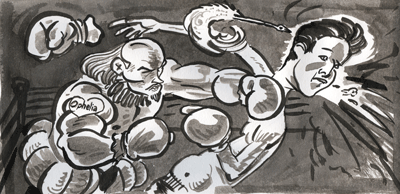only magazine
↵ home
Boxing Shakespeare

By Alan Hindle
Wednesday February 15, 2006
To beat or not to beat Apparently William Shakespeare wasn’t a balding turtle egg with a penciled moustache, but a robust young hunk looking like Ethan Hawke (if that’s your idea of a hunk) or maybe Paul Bethany (I think we’ll leave this stream of torture now).
73 year-old former Ottawa engineer Lloyd Sullivan’s mother’s dying wish was that he finally, after several generations of procrastination, get around to determining whether a certain Ethany-Hawkeish painting in the family’s possession is the only true portrait of William Shakespeare. Sullivan has devoted his life and money researching whether his painting by Elizabethan set painter John Sanders is the real face of the author of Hamlet. There are dozens of conflicting portraits floating about. The most commonly known is a posthumous engraving by Martin Droeshout (if you think of Shakespeare it’s the most likely face you’ll think of). One famous painting, known as the Flower Portrait, bears the closest resemblance to Droeshout’s deathmask scratchings, but has been proven through paint chip analysis to have been actually painted in the 19th century. The other main contender, the so-called “Chandos Shakespeare” shows a rougher, meaner bard. One likely to hold a knife to your throat and whisper, “Where are the diamonds?”
The National Portrait Gallery in London are holding an exhibition called Searching For Shakespeare from March 2 to May 29, as well as lectures discussing what the most famous playwright in history looked like. Given that debate still rages as to whether Shakespeare even existed, is there any point?
Various conspiracy theories lurk in the pantaloons of academia. Some aspiring doctorates hold that Edward de Veres, 17th Duke of Oxford actually wrote all those plays, or that Francis Bacon didn’t have enough on his plate already but also produced dozens of future film vehicles for Kenneth Branagh and Judy Dench. Christopher Marlowe, assassinated in Deptford in 1593 while a secret agent for the queen, apparently faked his death so he could lurk in the shadows and pump out several plays a year under the name. Other possibilities include William Stanley, Squarepants Spongebob, Sir Walter Raleigh and Queen Elizabeth I– because god forbid some struggling, punk poet should produce transcendent works of art.
In Justin MacGregor’s new play Boxing Shakespeare, Jason, a young poet with a shaky grasp of reality, is dumped by his girlfriend and begins hallucinating that The Bard is haunting him. So he chops off William’s arms and legs and keeps him in a box. No, that’s something else. In this play Shakespeare turns up and tortures Jason by repeatedly punching the stuffing out of him. We’re obviously looking at the Chandos Shakespeare here and Jason’s lucky he doesn’t get a shiv to the gizzard. It doesn’t matter what the man looked like, or who he was, or wasn’t, but rather about who we are, having been shaped by four centuries of his pervasive influence.
Boxing Shakespeare is about reawakening one’s sense of curiosity and love for the world, oneself and art. Writer/director MacGregor, who made the film Vigil a few years back about a bunch of grunge fans on a pilgrimage to Seattle after the death of Kurt Cobain, comes from a family of classical actors, and it’s good to see someone not afraid of monkeying with an overly revered icon. Don’t get me wrong, I love William, he just scares me a little. I wish he’d stop hanging around my alley fingering his switchblade.
Boxing Shakespeare plays Feb 15-25, 2006 at the Beaumont Studios Theatre, 316 West 5th>
